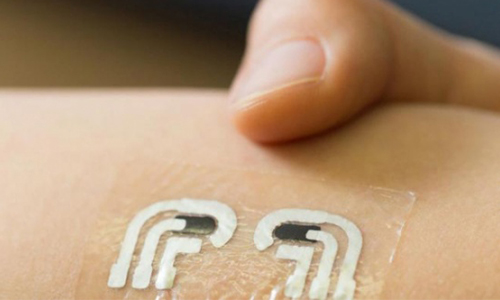UCSD launching pilot trial of glucose-sensing ‘tattoo’
April 25, 2018
Source: MobiHealthNews
 936
936

Researchers from the University of California San Diego have developed a low-cost, single-use tattoo-like wearable that measures the user’s glucose levels. According to a release from the institution, this noninvasive technology will be at the center of a newly announced pilot clinical trial designed to test the accuracy and acceptability of the tattoos.
“Drawing blood is uncomfortable. No one likes doing it. The beauty of the technology we are developing is that it is a truly noninvasive means to measure glucose,” Patrick Mercier, an assistant professor in the Department of Electrical and Computer Engineering at UCSD and codirector of its Center for Wearable Sensors, said in a statement. “The main purpose of our research is to develop new technologies that can monitor glucose without drawing blood and ideally measure it over the course of the day. By giving this real-time information to patients, they can manage their consumption of sugars and injections of insulin much better than with periodic spot measurements.”
The sensor itself is flexible and ultra-thin, and adheres to the user’s skin. By measuring glucose levels present in sweat — which prior research has indicated correlates with blood glucose levels — the device offers an alternative to the needle insertions and finger stick calibrations diabetes patients rely on to manage their conditions throughout the day. Mercier also said in the statement that these wearable devices could be produced en masse at the price of approximately one dollar each — roughly the same price as a traditional glucose test strip.
“Just like a kid’s temporary tattoo, you apply it on the arm, dab with water and remove the back paper,” Mercier said. “Our tattoo, however, is printed with material containing two electrodes that apply a small amount of electrical current. This forces glucose molecules that reside below the skin to rise to the surface, allowing us to measure blood sugar. It’s safe and you can’t really feel it.”
To test these sensors, Dr. Edward Chao, associate clinical professor of medicine at UCSD School of Medicine, Mercier, and others are enrolling 50 adults aged 18 to 75 years with Type 1 diabetes, Type 2 diabetes, or diabetes resulting from other causes into the ENGAGE pilot clinical trial, which is scheduled to conclude in June 2019. In it, patients wearing the sensors will receive a minimum of two doses of pilocarpine gel to induce sweat, which will then be measured by both the novel wearables and a glucometer. These measurements will occur at fasting and at time points ranging between 15 to 200 minutes post meal.
While the primary aim of the study is to ensure that the sensor’s glucose readings are on par with those collected through established means, the researchers said that they will also be looking at whether participants find use of the sensor to be acceptable, and how the sensor may eventually be updated to provide more than just a single readout per use.
Noninvasive blood glucose monitoring are a long-standing focus for the world of digital health. Just this year, San Francisco-based Sano received a $6 million investment from Fitbit for its mobile app and patch-like glucose sensor. Contact lenses have also been a focus, most recently with news of a smart, glucose-sensing research project described by a team of South Korean researchers. In 2017, researchers from Stanford and the University of California, Berkeley detailed a wrist-worn band embedded with flexible sensors and microprocessors that could potentially diagnose diabetes or other diseases.
By DduRead more on
- Things to Know before Buying Newborn Baby Incubators March 31, 2022
- Highly Resistant Food Poisoning Bug Responds to Antibiotics September 6, 2018
- Smartphone Based Diagnosis to Identify Mosquitoes Transmitting Infection September 5, 2018
- 3 Natural Plant Extracts Manufacturers on Drugdu.com September 4, 2018
- Shenzhen Chuanggan – Health Assessment Facility Supplier September 4, 2018
your submission has already been received.
OK
Subscribe
Please enter a valid Email address!
Submit
The most relevant industry news & insight will be sent to you every two weeks.



